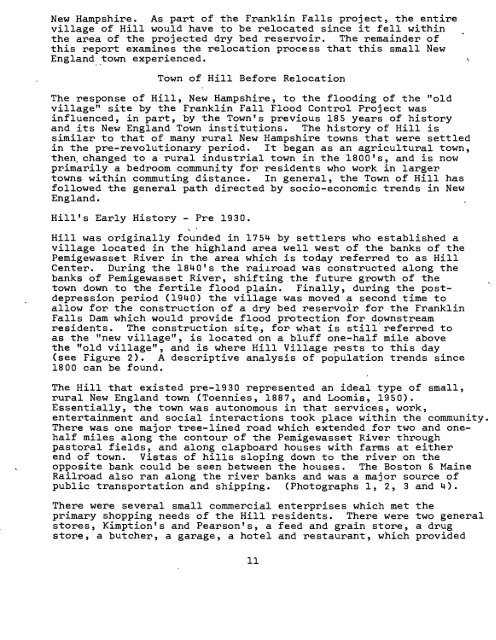; SP- IWR° CONTRACT REPORT 78-4... , UNDER ... - IWR - U.S. Army
; SP- IWR° CONTRACT REPORT 78-4... , UNDER ... - IWR - U.S. Army
; SP- IWR° CONTRACT REPORT 78-4... , UNDER ... - IWR - U.S. Army
Create successful ePaper yourself
Turn your PDF publications into a flip-book with our unique Google optimized e-Paper software.
New Hampshire. As part of the Franklin Falls project, the entire<br />
village of Hill would have to be relocated since it fell within<br />
the area of the projected dry bed reservoir. The remainder of<br />
this report examines the relocation process that this small New<br />
England town experienced.<br />
Town of Hill Before Relocation<br />
The response of Hill, New Hampshire, to the flooding of the "old<br />
village" site by the Franklin Fall Flood Control Project was<br />
influenced, in part, by the Town's previous 185 years of history<br />
and its New England Town institutions. The history of Hill is<br />
similar to that of many rural New Hampshire towns that were settled<br />
in the pre-revolutionary period. It began as an agricultural town,<br />
then, changed to a rural industrial town in the 1800's, and is now<br />
primarily a bedroom community for residents who work in larger<br />
towns within commuting distance. In general, the Town of Hill has<br />
followed the general path directed by socio-economic trends in New<br />
England. ,<br />
Hill's Early History - Pre 1930.<br />
Hill was originally founded in 1754 by settlers who established a<br />
village located in the highland area well west of the banks of the<br />
Pemigewasset River in the area which is today referred to as Hill<br />
Center. During the 1840's the railroad was constructed along the<br />
banks of Pemigewasset River, shifting the future growth of the<br />
town down to the fertile flood plain. Finally, during the postdepression<br />
period (1940) the village was moved a second time to<br />
allow for the construction of a dry bed reservoir for the Franklin<br />
Falls Dam which would provide flood protection for downstream<br />
residents. The construction site, for what is still referred to<br />
as the "new village", is located on a bluff one-half mile above<br />
the "old village", and is where Hill Village rests to this day<br />
(see Figure 2). A descriptive analysis of population trends since<br />
1800 can be found.<br />
The Hill that existed pre-1930 represented an ideal type of small,<br />
rural New England town (Toennies, 1887, and Loomis, 1950).<br />
Essentially, the town was autonomous in that services, work,<br />
entertainment and social interactions took place within the community.<br />
There was one major tree-lined road which extended for two and onehalf<br />
miles along the contour of the Pemigewasset River through<br />
pastoral fields, and along clapboard houses with farms at either<br />
end of town. Vistas of hills sloping down to the river on the<br />
opposite bank could be seen between the houses. The Boston & Maine<br />
Railroad also ran along the river banks and was a major source of<br />
public transportation and shipping. (Photographs 1, 2, 3 and 4).<br />
There were several small commercial enterprises which met the<br />
primary shopping needs of the Hill residents. There were two general<br />
stores, Kimption's and Pearson's, a feed and grain store, a drug<br />
store, a butcher, a garage, a hotel and restaurant, which provided<br />
11<br />
\







